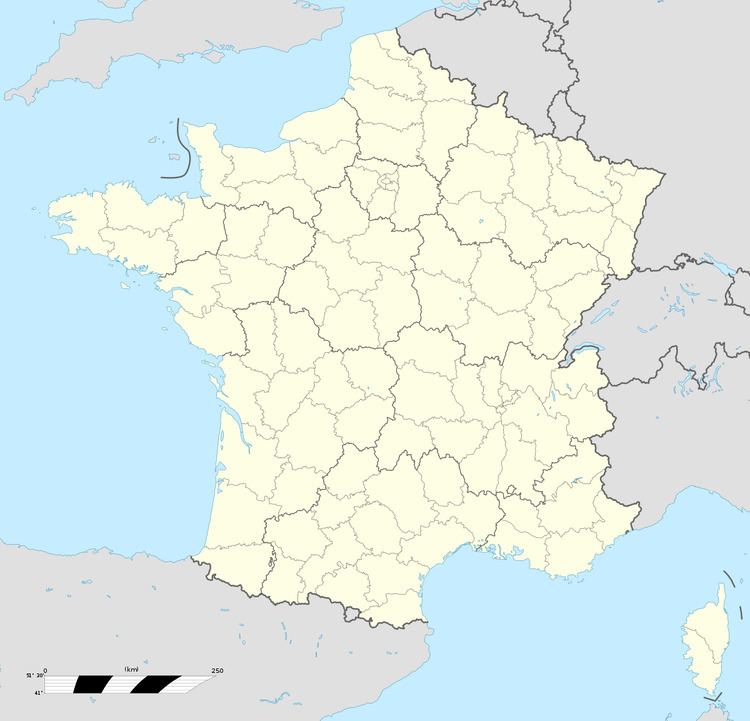Airport type Public Serves Pontoise 05/23 1,689 Phone +33 1 30 31 23 08 | Operator Aeroports de Paris Elevation AMSL 325 ft / 99 m Code POX | |
 | ||
Location Boissy l'Aillerie, France Address Parc naturel régional du Vexin français, Zone Sud, 95650 Boissy-l'Aillerie, France | ||
Pontoise Aerodrome or Pontoise – Cormeilles Aerodrome (French: Aérodrome de Pontoise - Cormeilles) (IATA: POX, ICAO: LFPT) is an airport located 7 km (3.8 NM) northwest of Pontoise in Boissy l'Aillerie near Cormeilles-en-Vexin, all communes of the Val-d'Oise department in the Île-de-France region in northern France. The airport is also located 16 miles (26 km) northwest of Paris.
Contents
- History
- German use during the Second World War
- American use
- Modern
- Facilities
- Airlines and destinations
- Flying clubs
- Relics
- References
It supports mostly general aviation. Scheduled flights to Brighton (south of London) by Brighton City Airways ended on 6 May 2013
History
Built in 1937, the airfield was used by the French Army prior to the Second World War.
German use during the Second World War
Seized by the Germans in June 1940 during the Battle of France, Cormeilles-en-Vexin was used as a Luftwaffe military airfield during the occupation. Known units assigned (all from Luftlotte 3, Fliegerkorps IV):
KG 76 participated in the Battle of Britain; KG 53 and KG 6 performed night bombing raids over England; KG 6 was a day interceptor unit against Eighth Air Force bombing raids; KG 66 flew raids over Allied shipping around England. The Luftwaffe also constructed two concrete, all weather runways, both of which are still in use today.
Largely due to its use as a base for Fw-190 interceptors, Cormeilles was attacked by USAAF Ninth Air Force B-26 Marauder medium bombers and P-47 Thunderbolts mostly with 500-pound General-Purpose bombs; unguided rockets and .50 caliber machine gun sweeps when Eighth Air Force heavy bombers (B-17s, B-24s) were within interception range of the Luftwaffe aircraft assigned to the base. The attacks were timed to have the maximum effect possible to keep the interceptors pinned down on the ground and be unable to attack the heavy bombers. Also the P-51 Mustang fighter-escort groups of Eighth Air Force would drop down on their return to England and attack the base with a fighter sweep and attack any target of opportunity to be found at the airfield.
American use
It was liberated by Allied ground forces about 6 September 1944 during the Northern France Campaign. Almost immediately, the United States Army Air Forces IX Engineer Command 818th Engineer Aviation Battalion cleared the airport of mines and destroyed Luftwaffe aircraft. Due to the Allied air attacks on the base, a significant amount of battle damage was sustained, which needed to be repaired to put the base back into operational use. The airport became a USAAF Ninth Air Force combat airfield, designated as "A-59" about a week later, on 15 September. It was also known as "Cormeilles-En-Vexin Advanced Landing Ground".
Under American control, the Ninth Air Force assigned the 344th Bombardment Group, flying B-26 Marauder medium bombers to the airfield on 30 September 1944, remaining at the base until 9 April 1945. The 410th Bombardment Group replaced the 344th with A-26 Invader medium bombers in May, remaining until June when they were withdrawn. The Americans returned full control of the airport to French authorities on 17 July 1945.
A memorial to the American use of the airport has been erected near the control tower
Modern
After the war, the airport was refurbished and reopened for public use in August 1946. Since April 21, 1949, the airport has been managed by Aéroports de Paris. What appears to be a government or military aircraft parking ramp on the southeast side of the airfield, along with several new hangars and support infrastructure, are separate from the civil airport.
In the past, there were scheduled flight by Aigle Azur (between 1988 and 1995) and Debonair (between November 1998 and October 1999) have operated from the airport daily to London (Gatwick and Luton), using Embraer and BAe 146-100 and 200. In addition, there were also seasonal daily flights to Brighton operated both by Skysouth using a Piper Chieftain and subsequently Brighton City Airways.
Facilities
The airport resides at an elevation of 325 feet (99 m) above mean sea level. It has two paved runways. The main runway is 05/23 which measures 1,689 by 50 metres (5,541 ft × 164 ft) and is equipped with ILS. The secondary runway is 12/30 measuring 1,650 by 50 metres (5,413 ft × 164 ft).
Airlines and destinations
Effective 7 May 2013 there are no regular passenger services.
Flying clubs
Relics
Many wartime relics can be found at the airport:
